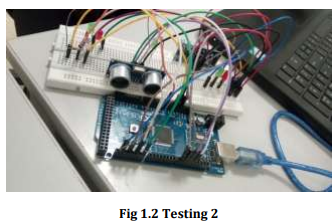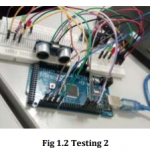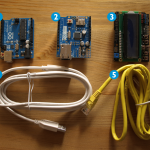
1. INTRODUCTION
The street lighting is one of the largest energy expenses for a city. An intelligent street lighting system can cut municipal street lighting costs as much as 50%-70%. An intelligent street lighting system is a system that adjusts light output based on usage and occupancy, i.e., automating classification of pedestrian versus cyclist, versus automotive. An intelligent street light management proposes the installation of the wireless based system to remotely track and control the actual energy consumption of the street lights and take appropriate energy consumption reduction measures through power conditioning and control. The street light controller should be installed on the pole lights which consist of Arduino along with LDR sensor and Ethernet shield module. The street light controller installed on the street light pole will control Lamp Street lighting depending on traffic flow, communicate data between each street light. The data from the street light controller can be transferred to base station using wireless technology to monitor the system. The mode of operation of the system can be conducted using auto mode and manual mode. The control system will switch on-off the lights at required timings and can also vary the intensity of the street light according to requirement. In the second scenario the
percentage of vehicle accident on U-turn present on hilly areas. In the proposed system the vehicle accident on sharp U-turn prevented by alerting vehicle drivers using Red and Green LED’s, where Red And Green colour has there as usual traffic signal meanings. This system implemented by using smart ultrasonic sensors implemented on the both side of road. Hence after getting alert the either side of driver will stop the vehicle and accident can be prevented.
2. SYSTEM PERSPECTIVE
The major functionalities of the system are: The IoT enabled system will be able to show the real time status of the street lamps and will also be able to avoid
accidents present on U-turns in hilly areas. The LDR Sensor senses the external light intensity and accordingly control street lamp based on light intensity. The real time readings of the LDR will be shown on the local web server created using arduino platform. The real time ON/OFF status of the lamps will also be shown on the local webserver. The ultrasonic sensor senses the nearby vehicle passing at some distance near the traffic signal on the both side of U–turn. The alert signal is given to the vehicle driver if the vehicle coming from the other side. The status of the traffic signal (Red and Green LED) will be shown on the local web server.
3. PROPOSED SYSTEM
The Proposed system consists of two modules. The First module consist of smart street lighting system which saves the electricity to greater extend. This module is implemented using LDR Sensor. The External light intensity is sensed by LDR and it sends the analog values of light intensity to the arduino. If the light intensity is very poor then street lamps are automatically turned on by arduino. Then the analog values are also simultaneously sent to the webserver created using arduino mega 2560 and Ethernet shield W5100. The webserver also has login portal for the safety purpose. In the second module the accidents are prevented at U-turns present at hilly areas using ultrasonic sensor and Red and Green LED’s which are used to convey the as usual traffic signal meanings. The ultrasonic sensors are fixed at both the sides of U-turn. Whenever the vehicle passes by the ultrasonic sensor present on either side of a road then Red LED gets turned on, on the other side of U-turn and vice versa. Rest of the time Green LED will remain on. Even though the care has been taken to prevent accident on U turn, if accident occurs then vibration sensor will detect the occurrence of accident and will send alert on the webserver requesting to send emergency help at accident spot.
4. BLOCK DIAGRAM

5 .HARDWARE USED
A. Arduino Mega 2560- In Arduino mega 2560 is a development board which has 54 Input / Output pins. Out of which 16 are analog pins. This board can be powered up by using either by adapter or battery supply or USB Printer Cable attached to PC. The Code can be inserted directly into the board using USB Printer Cable. The board has internal 10 bit ADC present within it to do the analog to digital conversion.

B. Ethernet Shield W5100
The Arduino Ethernet Shield V1 allows an Arduino board to connect to the internet. It is based on the Wiznet W5100 Ethernet chip. The Wiznet W5100 provides a network (IP)
stack capable of both TCP and UDP. It supports up to four simultaneous socket connections. Use the Ethernet library to write sketches which connect to the internet using the shield. The Ethernet shield connects to an Arduino board using long wire-wrap headers which extend through the shield. This keeps the pin layout intact and allows another shield to be stacked on top.

C. Ultrasonic Sensor HC SR-04
This is the sensor which is used to measures the distance. This sensor has four pins. These pins are VCC, GND, TRIG and ECHO. The Sensor measures the distance from 2 cm to 400
cm.

D. LDR Sensor
Light Dependent Resistor is a sensor which detects external light intensity. It is 5mm sensor in size. The working principle of LDR is that, its resistance decreases with increase in light intensity. In the proposed system the LDR detects the light intensity and then accordingly control street lamps.

E. Router
Router is a network device which forwards data packets within communication network. Router performs traffic directing function in internet. In the proposed system the router is the interface between the Ethernet shield W5100 and Web Interface. The system gets connected to the internet through router after getting access to ISP (Internet Service Provider). ISP provides access to the WWW (World Wide Web).

5. SOFTWARE REQUIRED
Arduino IDE- Arduino IDE is compiler used to write the code for Arduino based systems. The compiler has various tools such as serial monitor, serial plotter, etc. The code written in Arduino IDE can be directly burned into the Arduino board using USB Printed cable which we used to power up arduino board. The compiler is easy to use and has many helpful tools.

A. Notepad
Notepad is a text editor present in windows operating system. In the proposed system we are using the notepad to write the HTML (Hypertext Markup Language) code to design web pages.

6. TESTING

7. CONCLUSION AND FUTURE WORK
The Proposed IoT project “Implementation of Intelligent and safe smart city concept using IoT approach” is cost effective, Practical, eco-friendly and safest way to save energy and human life and as this system is connected to the internet, hence can be accessed at anytime, anywhere across the globe. It clearly tackles the two problems that world is facing today, saving of energy and also accident prevention, very efficiently. Initial cost and maintenance can be the draw backs of this project. With the advances in technology and good resource planning the cost of the project can be cut down and also with the use of good equipment the maintenance can also be reduced in terms of periodic checks. The LEDs have long life, emit cool light, and can be used for fast switching. For these reasons proposed system presents far more advantages which can overcome the present limitations. Keeping in view the long term benefits and the initial cost would never be a problem as the investment return time is very less. The proposed system has scope in various other applications like for providing lighting in industries, campuses and accident prevention scheme for smart cities.
7. REFERENCES
[1] X. Y. Jing, F. Wu, Z. Li, R. Hu and D. Zhang, “Multi-Label Dictionary Learning for Image Annotation,” in IEEE Transactions on Image Processing, vol. 25 no. 6, pp.2712-2725, June 2016.
[2] Archana. G, Aishwarya N, Anitha J “Intelligent Street L ight System” International Journal of Recent Advances in Engineering & Technology, Vol-3, Issue-4, 2015.
[3] Akshay Balachandran, Murali Siva, V. Parthasarathi, Surya and Shriram K. Vasudevan “An Innovation in the Field of Street Lighting System with Cost and Energy Efficiency”Indian Journal of Science and Technology,Vol-8, August 2015.



COMMENTS